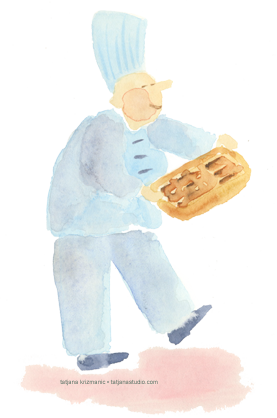Award Winning Author
Face Reading with Before & After Photos
Tasty Wheat Alternatives
Accompanying recipe: Buckwheat Crepes
If you are among the fast growing population that is allergic to gluten, don’t despair. Here’s how to enjoy bread, pasta and cookies…albeit, wheat-free.
First, identify any problematic foods that trigger your reactions and then avoid eating them while your digestive system repairs. Wheat and dairy are the most common allergens. Others include: corn, rice, other gluten grains (barley and rye), oats, soy, eggs, nuts, citrus, shell fish and fish. Gluten sensitivities range from mild to life-threatening; consult your doctor as necessary.
Because wheat is versatile and inexpensive, it’s used in most packaged and restaurant foods. When shopping, read labels carefully. Depending upon how it’s processed, wheat is labeled as bran, bulgur, cous cous, flour, gluten, pasta and semolina.When eating out, insist on gluten-free options. Better yet, shedule in time for more home cooking. If this feels daunting, take a cooking class for inspiration and support.
Below I’ve listed wheat substitutes. They are, however, substitutes as only wheat tastes, smells and performs like wheat. It is wheat gluten that enables bread to rise, pastry to have a tender flake and pasta to be firm and al dente but not soggy. However, in some uses the alternatives are more delicious than wheat as, for example, a Buckwheat Crepe.
While it’s a challenge to make a good wheat-free leavened bread, you can easily make tasty and exotic wheat-free quick breads, cakes, cookies and sauces. My web page and book, The Splendid Grain, provide several hundred wheat-free recipes. My favorite wheat-free pastas are Asian (rice noodles or threads, mung bean pasta and shiritake). Commercially made wheat-free breads and pastries have increasing availability in natural food stores and quality bakeries.
WHEAT-FREE OPTIONS
1. Cereal Grains Barley, corn, millet, oats, rice, rye, sorghum, tef and wild rice are all in the same cereal grain family as is wheat. All flours ground from cereal grains may be used as a wheat substitute. Commonly available are barley, buckwheat, corn, rice and rye flour. The less utilized flours may be purchased online or from natural food stores. Note: people with a gluten allergy must also avoid barley, oats and rye.
2. Non-Cereal Grains Amaranth, quinoa and buckwheat are three grain-like seeds unrelated to cereal grains. (Despite its name, buckwheat is not a wheat-relative.) It is rare for anyone to develop a sensitivity to these non-cereal grains. Amaranth, quinoa and buckwheat are gluten-free and therefore not suitable for making leavened bread; however, they make excellent quick breads and cookies.
3. Nut Meal Ground nuts such as almonds, hazelnuts or walnuts make the richest flour substitute for cookies and cakes. Because their fragile fatty acid content gives them a brief shelf life, it’s preferable to grind your own nuts in a food processor just prior to use. Nut meal requires a binding agent such as eggs. Because chestnuts are lower in fat than other nuts, chestnut flour has a longer shelf life. It is available online.
4. Bean Flour, NOT RECOMMENDED Dried beans, such as navy, pinto, soy and chickpeas may be milled and used, in combination with other flours, as a wheat alternative. However, they make baked goods dense and hard to digest; or for many people indigestible.
5. Other Flour Substitutes Potato starch, arrowroot powder, cornstarch and tapioca are thickening agents that substitute for wheat in sauces and gravy. In baked goods these starchy ingredients serve as a binding agent.
In conclusion, to successfully avoid gluten takes work. But the pay off in better health makes it a small price to pay. For personalized help, consider a Diet Consultation and Face Reading with me. You’ll learn to clearly see the results of eating (or not) eating wheat in both your facial features and overall energy.
May you be well nourished,
Rebecca Wood


Good day
I need ideas what to eat for breakfast that is wheat free.
Check out my book, The Whole Bowl.
Within four months of going wheat free, my cholesterol dropped from 220 to 167; and my tryglycerides from 180 to 72. Once being diagnosed as pre-diabetic, my blood sugars have now stabilized around 80. You can’t argue with the numbers!!
Congratulations! And you feel so much better. Right?
According to some new research, wheat may be bad for everybody. Genetically modified wheat, since the sixties and seventies for high yield and aphid resistance, has a new protein, indigestible to humans. Causes all kinds of health problems, it turns out. Everyone should limit or eliminate it from their diets. Maybe if we make bad, altered foods unpopular enough, greed motivated companies like Monsanto, will stop fooling with nature and ruining decent foods for us!!
Thank you! This is fantastic. I think my wheat sensitivity has been brought on by pregnancy too, and the same results are symptoms in my baby daughter, so I’m so glad there are this many alternatives! It seems like every thing has wheat in it at the moment, so I’ll be going to the kitchen to work on some new recipes.
I recently developed a boatload of allergies a few months ago after having my third child. If it weren’t for me tracking everything I eat on the Weight Watchers Program, I probably would have gone nuts( another allergy of mine)trying to figure out what was wrong with me. My most recent allergy discovery is wheat, and as devestating as that is to me I am trying to work through it by staying optimistic and this information that you have provided has been a Blessing to me. Thank you so much!
Thank you so very much… My sister in law and niece are always finding new ways to “preach” to me about healthy eating etc etc etc… but this one column about Tasty Wheat Alternatives really helped me.. thank you… 🙂